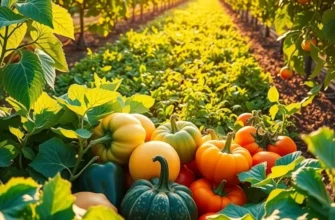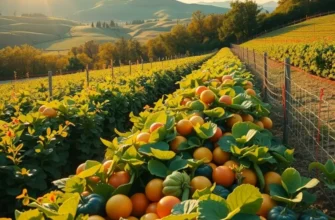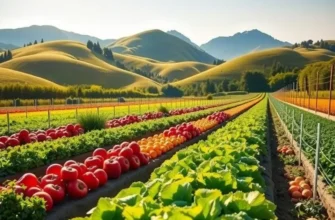Creating meals with a lower environmental footprint is a rewarding pursuit for anyone keen on making sustainable choices. As climate change concerns mount, individuals increasingly seek ways to align their food habits with eco-friendly practices. By making thoughtful decisions about what we eat, how we source our ingredients, and how we prepare meals, we can significantly reduce our impact on the planet while still enjoying delicious food. Here, we explore practical strategies for making your meals more sustainable and planet-friendly.
Embrace Local and Seasonal Ingredients

Embracing local and seasonal ingredients is a powerful way to make your meals more eco-friendly. By choosing nearby sources, you reduce the carbon footprint associated with transporting food over long distances. Less fuel used means fewer emissions polluting the environment, which is a significant step towards sustainability.
In addition to environmental benefits, supporting local farmers helps sustain their livelihoods and enriches the local economy. It creates a robust community where producers and consumers can engage more directly. This personal connection often leads to better quality produce and a deeper understanding of food origins.
Local ingredients usually mean fresher, tastier food. Harvested at peak ripeness and quickly brought to market, they retain more nutrients and flavors compared to items imported from distant locations. You’ll likely find less need for excessive seasoning or enhancements, as the natural flavors shine through.
Finding local produce isn’t as daunting as it may seem. Farmer’s markets are a great starting point, often providing an array of fresh fruits, vegetables, and herbs. Community-supported agriculture (CSA) programs allow you to have a share in a local farm’s harvest, ensuring a diverse selection of seasonal produce. Additionally, check local grocery stores that showcase nearby farmers’ products.
Seasonal eating revolves around consuming foods that are naturally available during certain months. This practice aligns with nature’s cycles and can even introduce variety to your meals throughout the year. In the spring, celebrate with asparagus and strawberries; summer invites zucchini and sweet corn, while autumn brings apples and pumpkins. Winter favorites might include root vegetables and hearty greens.
Incorporating these ingredients into meals can be both fun and rewarding. For breakfast, consider a seasonal fruit parfait with yogurt and granola. Lunch could be a vibrant salad featuring mixed greens, radishes, and fresh herbs, drizzled with local honey vinaigrette. Dinner might involve roasting seasonal vegetables and pairing them with a protein of choice, turning a simple dish into a culinary delight through the rich flavors.
To amplify your sustainable cooking efforts, check out practical tips on eco-smart kitchen storage that complement these fresh, local ingredients. By ensuring proper storage, you can maximize the longevity and minimize waste of your local produce.
Ultimately, embracing local and seasonal ingredients not only contributes to environmental health but also enhances your culinary experiences. Each meal becomes an opportunity to connect with the land and community, savoring more than just tasty dishes but also the stories and efforts behind them.
Minimize Food Waste Through Smart Meal Planning

Incorporating smart meal planning strategies is essential for reducing food waste, thus ensuring eco-conscious meal preparation. A simple yet effective approach is to create a detailed shopping list before you head to the grocery store. By planning meals ahead of time, you can make precise purchase decisions, buying only what you’ll use, which reduces food spoilage and waste.
Meal prepping can further streamline this process. By dedicating time to batch cook meals, you not only save time during the week but also optimize the use of ingredients, minimizing the chances of spoilage. Prepping meals or ingredients allows for efficient management of perishable items, leading to a significant cut in kitchen waste. For meals requiring minimal prep time, you can explore handy minimal prep dinner ideas.
Utilizing leftovers creatively is another vital strategy. Rather than letting yesterday’s meal go to waste, transform it into something new. Leftover veggies can be turned into a frittata, while cooked grains can be repurposed into salads or stir-fries. Embracing such practices not only decreases waste but also enhances culinary creativity.
In your quest to minimize food waste, consider composting non-consumable scraps. Composting turns organic waste, like vegetable peels and coffee grounds, into nutrient-rich soil, closing the loop in the food cycle. This sustainable practice nourishes gardens and reduces the volume of waste sent to landfills.
To make your kitchen more efficient and eco-friendly, equip it with tools that support sustainability. For example, purchase air-tight containers to extend the shelf life of dry goods. Labeling containers and freezing perishables can help keep track of expiration dates, which prevents food from going to waste.
In conclusion, adopting these smart meal planning strategies and habits can remarkably reduce food waste in your kitchen. Not only do these efforts benefit the environment, but they also promote efficient and thoughtful meal preparation in your day-to-day life.
Final words
By incorporating local and seasonal ingredients into your meals and actively working to minimize food waste, you not only improve your diet but also contribute positively to the environment. Every small effort makes a difference. As you embrace these sustainable practices, remember that every meal is an opportunity to support the planet’s health. Commit to viewing food through an eco-conscious lens, and inspire friends and family to join you in making choices that are beneficial for both your health and the Earth. Together, our collective actions can lead to a more sustainable and livable world.








